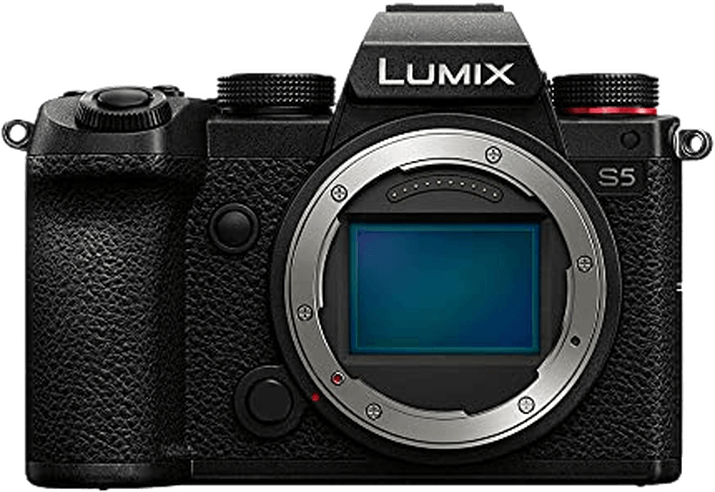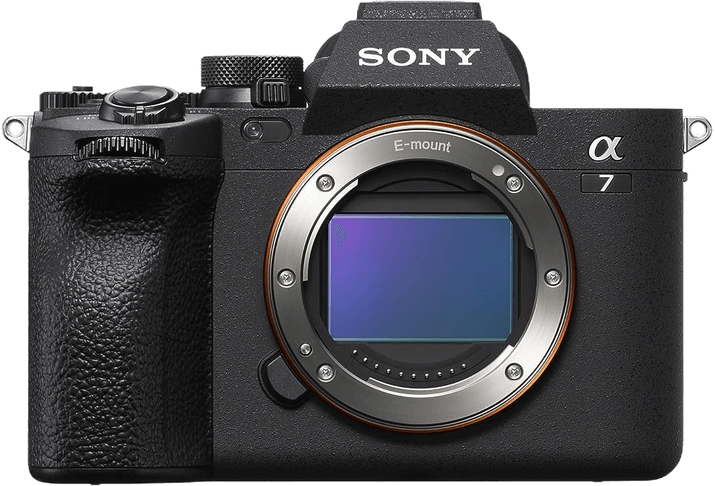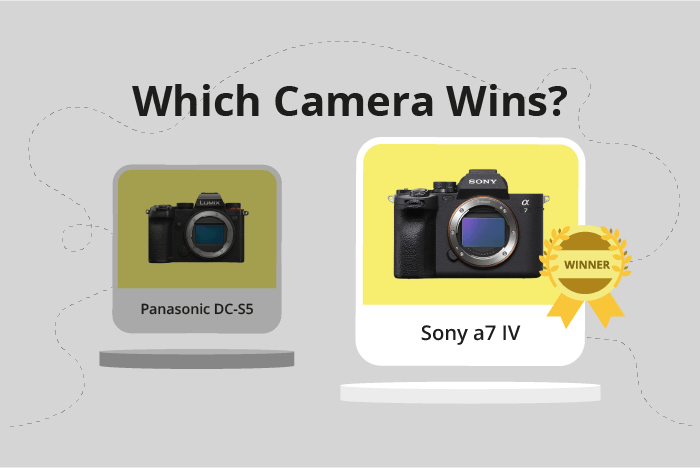Panasonic Lumix DC-S5 vs Sony a7 IV Comparison
Panasonic Lumix DC-S5

Sony a7 IV

The Sony a7 IV outperforms the Panasonic Lumix DC-S5 with a score of 84/100 compared to the DC-S5’s 79/100. Both cameras are mirrorless and were released in 2021, with the DC-S5 announced on 02/09/2021 and the a7 IV on 10/21/2021. They share similar dimensions, with the DC-S5 measuring 133 x 97 x 82mm and the a7 IV slightly smaller at 131 x 96 x 80mm.
The Sony a7 IV is superior due to its higher score, reflecting better overall performance. Additionally, it has a lighter weight of 659g (1.45lbs) compared to the DC-S5’s 714g (1.57lbs). However, the Panasonic Lumix DC-S5 has a lower launch price of $1999, while the Sony a7 IV is priced at $2499.
When considering these factors, the Sony a7 IV offers better performance and a more compact design, while the Panasonic Lumix DC-S5 provides a more budget-friendly option. Ultimately, the choice between the two cameras depends on individual preferences and requirements.
Panasonic Lumix DC-S5 vs Sony a7 IV Overview and Optics
The Sony a7 IV outperforms the Panasonic Lumix DC-S5 in optics with a score of 85/100 compared to the latter’s 78/100. Both cameras share some common specifications, such as a CMOS sensor, full-frame sensor size, and image stabilization. However, the Sony a7 IV boasts superior features that contribute to its higher score.
The Sony a7 IV has a higher megapixel count at 33, compared to the Panasonic Lumix DC-S5’s 24.2. This difference allows the Sony a7 IV to capture more detail and deliver higher resolution images. The shooting speed of the Sony a7 IV is also faster at 10 frames per second (fps), in contrast to the Panasonic Lumix DC-S5’s 7 fps. This advantage enables the Sony a7 IV to capture fast-moving subjects more effectively.
Furthermore, the Sony a7 IV’s sensor has a higher DXOMARK score of 97, while the Panasonic Lumix DC-S5’s sensor scores 94. The Sony a7 IV’s Bionz XR processor also contributes to its better performance in image processing and overall camera responsiveness.
The Panasonic Lumix DC-S5, despite scoring lower, has its merits. Its Leica L lens mount offers compatibility with a variety of high-quality lenses. This feature provides users with flexibility in choosing lenses to suit their photography needs.
To conclude, the Sony a7 IV excels in optics by offering higher resolution, faster shooting speed, and better sensor performance. The Panasonic Lumix DC-S5, while not as strong in these areas, has the advantage of lens compatibility through its Leica L mount. The choice between these two cameras will depend on a user’s priorities and preferences in terms of image quality, shooting speed, and lens options.
Panasonic Lumix DC-S5 vs Sony a7 IV Video Performance
The Panasonic Lumix DC-S5 and the Sony a7 IV are both excellent cameras, but when it comes to video capabilities, the Sony a7 IV takes the lead with a video score of 91/100, compared to the Panasonic Lumix DC-S5’s score of 83/100. Both cameras share similar video specifications, such as 4K max video resolution and dimensions of 3840 x 2160, as well as built-in time-lapse functionality.
The Sony a7 IV outperforms the Panasonic Lumix DC-S5 in video frame rate, offering a maximum of 120fps, while the Lumix DC-S5 only provides up to 60fps. This difference allows the Sony a7 IV to capture smoother slow-motion footage, giving users more flexibility in post-production.
However, the Panasonic Lumix DC-S5 is not without its strengths. With a video score of 83/100, it still delivers high-quality video performance, despite having a lower frame rate than the Sony a7 IV. For those who do not require the higher frame rate, the Lumix DC-S5 remains a solid choice.
Comparing the two cameras, the Sony a7 IV emerges as the better option for video capabilities due to its higher video score and superior frame rate. The Panasonic Lumix DC-S5, although not as strong in this area, still provides reliable video performance for users who do not prioritize high frame rates. Ultimately, both cameras offer impressive video features, but the Sony a7 IV stands out as the superior choice for videographers seeking smoother slow-motion footage and greater flexibility in post-production.
Panasonic Lumix DC-S5 vs Sony a7 IV Features and Benefits
The Panasonic Lumix DC-S5 outperforms the Sony a7 IV in features with a score of 85/100 compared to the Sony’s 83/100. Both cameras share several specifications, including a 3-inch screen, touchscreen capabilities, flip screen, GPS absence, and WIFI and Bluetooth connectivity.
The Lumix DC-S5 has a clear advantage in screen resolution, boasting 1,840,000 dots compared to the a7 IV’s 1,040,000 dots. This higher resolution provides a sharper and more detailed image preview and review experience, making it easier for photographers to assess their shots accurately.
On the other hand, the Sony a7 IV does not surpass the Lumix DC-S5 in any particular feature. However, it is worth noting that the two-point difference in the overall feature score is relatively small, and both cameras offer a solid set of features for their users.
When comparing the two cameras, the Panasonic Lumix DC-S5 stands out due to its superior screen resolution. This advantage enhances the user experience, making it a preferable choice for photographers who prioritize image preview and review quality. The Sony a7 IV, while not excelling in any specific area, still offers a competitive set of features that make it a strong contender in the market. Ultimately, the choice between these two cameras comes down to personal preferences and priorities, with the Lumix DC-S5 offering a slight edge in features.
Panasonic Lumix DC-S5 vs Sony a7 IV Storage and Battery
The Sony a7 IV outperforms the Panasonic Lumix DC-S5 in storage and battery, scoring 76/100 compared to the Panasonic’s 71/100. Both cameras feature two memory card slots and support USB charging. They also accept UHS-II compatible memory cards, with the Sony a7 IV offering additional compatibility with CFexpress Type A cards.
The Sony a7 IV excels with a longer battery life, providing 580 shots per charge using the NP-FZ100 battery, whereas the Panasonic Lumix DC-S5 delivers 440 shots with its DMW-BLK22 battery. This advantage makes the Sony a7 IV more suitable for extended shooting sessions without frequent battery replacements.
While the Panasonic Lumix DC-S5 falls behind in battery life, it still offers reliable performance with its 440 shots per charge. However, there is no distinct advantage for the Panasonic in the storage and battery category.
Considering the storage and battery aspects, the Sony a7 IV is the superior choice due to its longer battery life and additional memory card compatibility, while the Panasonic Lumix DC-S5 remains a solid option with its decent battery life.
Alternatives to the Panasonic Lumix DC-S5 and Sony a7 IV
Are you still undecided about which camera is right for you? Have a look at these popular comparisons that feature the Panasonic Lumix DC-S5 or the Sony a7 IV:

